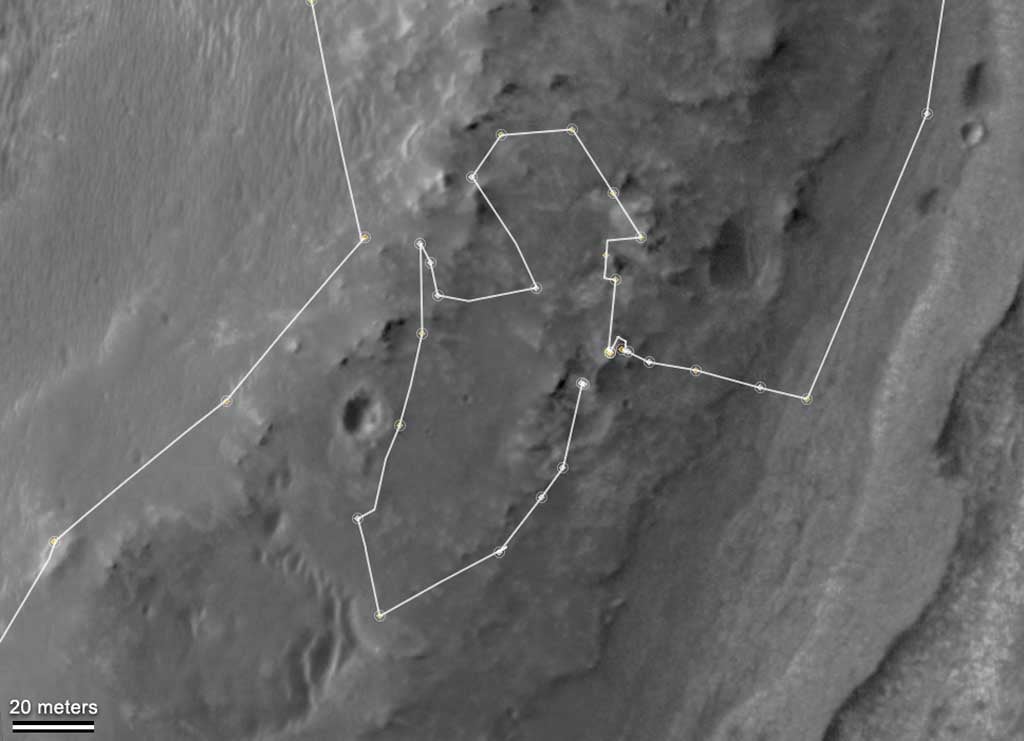“If you are a geologist studying a site like this, one of the first things you do is walk the outcrop, and that’s what we’ve done with Opportunity,” said Steve Squyres from Cornell University in Ithaca, New York.
Coming up on its ninth anniversary, Opportunity still is a capable robotic explorer. It has been investigating a crater-rim site where observations from orbiting Mars spacecraft detected traces of clay minerals, which form under wet, nonacidic conditions that can be favorable for life.
The rover team chose this site as a driving destination years earlier. The site is named Matijevic Hill in honor of the late Jacob Matijevic, who led the engineering team for the twin Mars exploration rovers Spirit and Opportunity for several years.
Opportunity drove about 1,160 feet (354 meters) in a counterclockwise circuit around Matijevic Hill in October and November, bringing the total miles driven on the mission to 22 (35 kilometers). Researchers used the rover to survey the extent of Matijevic Hill outcrops and identify the best places to investigate further.
“We’ve got a list of questions posed by the observations so far,” Squyres said. “We did this walkabout to determine the most efficient use of time to answer the questions. Now we have a good idea what we’re dealing with, and we’re ready to start the detailed work.”
The hill is on the western rim of Endeavor Crater, a bowl 14 miles (22km) in diameter. An impact from a celestial object dug this crater more than 3 billion years ago, pushing rocks onto the rim from a greater depth than Opportunity reached during its first several years on Mars. Since the impact, those rocks may have been altered by environmental conditions. Sorting out the relative ages of local outcrops is a key to understanding the area’s environmental history.
“Almost nine years into a mission planned to last for three months, Opportunity is fit and ready for driving, robotic-arm operations, and communication with Earth,” said Diana Blaney of NASA’s Jet Propulsion Laboratory (JPL) in Pasadena, California.
Two outcrops of high interest on Matijevic Hill are “Whitewater Lake” and “Kirkwood.” Whitewater Lake is light-toned material that science team members believe may contain clay. Kirkwood contains small spheres with composition, structure, and distribution that differ from other iron-rich spherules, nicknamed blueberries, that Opportunity found at its landing site and throughout the Meridiani Planum area it has explored. Squyres calls the Kirkwood spheres “newberries.”
“We don’t know yet whether Whitewood Lake and Kirkland are from before or after the crater formed,” he said. “One of the most important things to work out is the order and position of the rock layers to tell us the relative ages. We also need more work on the composition of Whitewater and debris shed by Whitewater to understand the clay signature seen from orbit and on the composition of the newberries to understand how they formed.”
“If you are a geologist studying a site like this, one of the first things you do is walk the outcrop, and that’s what we’ve done with Opportunity,” said Steve Squyres from Cornell University in Ithaca, New York.
Coming up on its ninth anniversary, Opportunity still is a capable robotic explorer. It has been investigating a crater-rim site where observations from orbiting Mars spacecraft detected traces of clay minerals, which form under wet, nonacidic conditions that can be favorable for life.
The rover team chose this site as a driving destination years earlier. The site is named Matijevic Hill in honor of the late Jacob Matijevic, who led the engineering team for the twin Mars exploration rovers Spirit and Opportunity for several years.
Opportunity drove about 1,160 feet (354 meters) in a counterclockwise circuit around Matijevic Hill in October and November, bringing the total miles driven on the mission to 22 (35 kilometers). Researchers used the rover to survey the extent of Matijevic Hill outcrops and identify the best places to investigate further.
“We’ve got a list of questions posed by the observations so far,” Squyres said. “We did this walkabout to determine the most efficient use of time to answer the questions. Now we have a good idea what we’re dealing with, and we’re ready to start the detailed work.”
The hill is on the western rim of Endeavor Crater, a bowl 14 miles (22km) in diameter. An impact from a celestial object dug this crater more than 3 billion years ago, pushing rocks onto the rim from a greater depth than Opportunity reached during its first several years on Mars. Since the impact, those rocks may have been altered by environmental conditions. Sorting out the relative ages of local outcrops is a key to understanding the area’s environmental history.
“Almost nine years into a mission planned to last for three months, Opportunity is fit and ready for driving, robotic-arm operations, and communication with Earth,” said Diana Blaney of NASA’s Jet Propulsion Laboratory (JPL) in Pasadena, California.
Two outcrops of high interest on Matijevic Hill are “Whitewater Lake” and “Kirkwood.” Whitewater Lake is light-toned material that science team members believe may contain clay. Kirkwood contains small spheres with composition, structure, and distribution that differ from other iron-rich spherules, nicknamed blueberries, that Opportunity found at its landing site and throughout the Meridiani Planum area it has explored. Squyres calls the Kirkwood spheres “newberries.”
“We don’t know yet whether Whitewood Lake and Kirkland are from before or after the crater formed,” he said. “One of the most important things to work out is the order and position of the rock layers to tell us the relative ages. We also need more work on the composition of Whitewater and debris shed by Whitewater to understand the clay signature seen from orbit and on the composition of the newberries to understand how they formed.”










